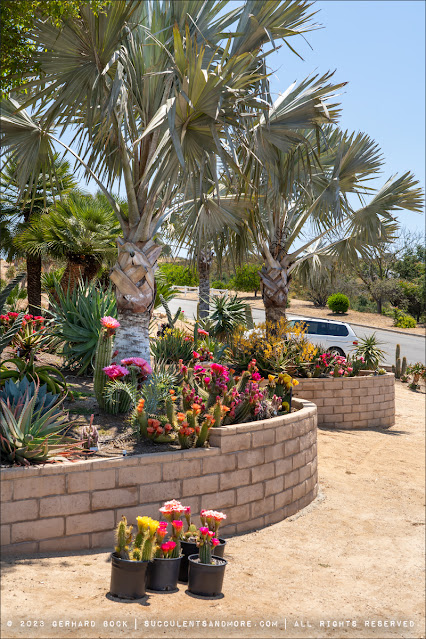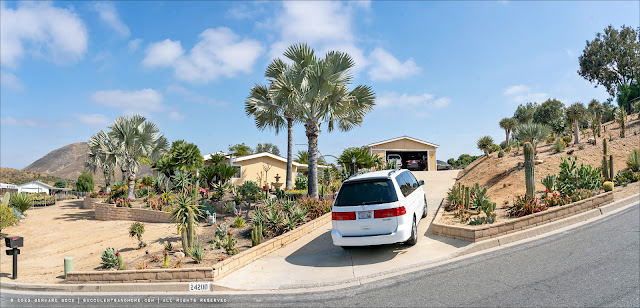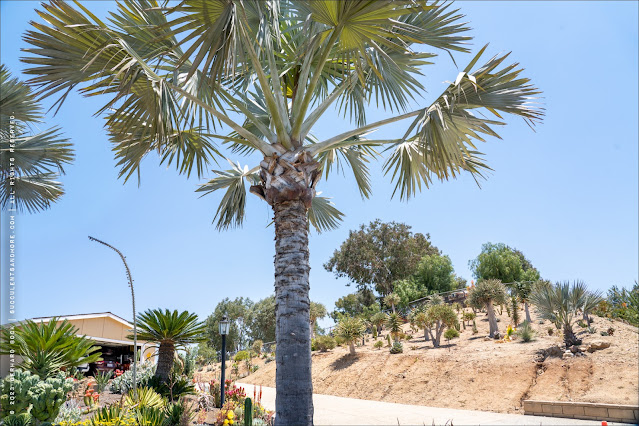When I was in Southern California for my daughter’s university graduation a couple of weekends ago, I took the opportunity to visit Brent Wigand in Wildomar, a town in Riverside County just north of the San Diego County line. Brent has created sought-after aloe hybrids like ‘Unicorn’ (Aloe peglerae × white-flowering Aloe ferox), ‘Superman’ (Aloe cameronii × white-flowering Aloe ferox), and ‘Maui Gem’ (Aloe mawii × globuligemma), but in recent years, his attention has been focused on echinopsis hybrids, both collecting and making his own.
Brent lives on a 1¾-acre property outside of Wildomar and sells plants from his backyard nursery by appointment. As I was driving up his street, I immediately knew which place was his. It’s easy to see why:
As soon as I stepped out of my car, I started to snap photos:
 |
| The street continues to climb |
 |
| Aloes, agaves, cacti and other succulents, plus cycads and palms: this is my kind of landscaping |

 |
| Bismarck palms (Bismarckia nobilis) with their graceful blue-gray fronds tower over Brent’s garden |
The hill across the driveway (see the last two photos for a wider view) is a dry garden that receives minimal supplemental irrigation. All the plants that live here are winter growers, i.e., they’re adapted to California’s winter-wet/summer-dry climate. This area gets watered only a handful of times during the dry season.
 |
| I couldn’t get over the sheer number of tree aloes, including Aloidendron dichotomum, Aloidendron ramosissimum (including hybrids between the two), and Aloidendron ‘Hercules’, as well as Aloe speciosa |
 |
| Even though the dry garden has excellent drainage thanks to its fairly steep slope, there are pockets of clay that retain water long enough to cause rot in more sensitive plants. This Aloidendron dichotomum rotted this past winter and is now waiting to be replanted. The pile it’s resting on is Brent’s custom-made potting mix. |
Brent’s greenhouse is a sight to see. Cacti everywhere, inside and outside, many of them blooming when I was there:
I asked Brent how many plants he has. He doesn’t really know, but he says he has about 600 different Echinopsis species, cultivars, and hybrids. He actively started collecting echinopsis about 12 years ago, but his interest in cacti began when he was five and got his first cactus from the local grocery store. He has a natural affinity for organization and classification – ideal qualities for a serious collector and plant grower.
 |
| The greenhouse is covered with 40% shade cloth |
A note on taxonomy: In 1974, a number of previously independent cactus genera were merged into the genus Echinopsis, including Trichocereus (tall columnar cacti) and Lobivia (small globular cacti). However, based on DNA evidence, Trichocereus and Lobivia were reinstated as separate genera in Taxonomy of the Cactaceae published in 2015. Since many “echinopsis” hybrids are a genetic mix of two or three of these genera, it makes sense to refer to them as Echinopsis. In common parlance, the taller columnar Trichocereus are often called “torch cacti.”
Echinopsis, Trichocereus, Lobivia, or whatever: Most people don’t care what the correct name is, they simply appreciate their beauty.
With thousands of plants in Brent’s collection, there’s aways something in bloom. The “Mega Bloom” –the first and biggest wave of flowers – is usually in April, but many hybrids rebloom multiple times throughout the summer. Here are some videos of the 2022 Mega Bloom that Brent posted on his Instagram account:
1 |
2 |
3 |
4. Take a few minutes to watch these videos; the sheer number of flowers is breathtaking.

 |
| Echinopsis ‘Serape’ |
 |
| Echinopsis ‘Serape’ |
 |
Echinopsis ‘Super Windigo’
|
 |
| Echinopsis ‘Super Windigo’, different plant, slightly different look |
 |
| Echinopsis ’Super Orange’ |
 |
| Unnamed Echinopsis hybrid |
 |
| Echinopsis ‘Flying Saucer’ flower with Brent’s hand for scale |
 |
| Echinopsis ‘Shades of Bourne’ |
 |
| Variegated Echinopsis |
Brent also has hundreds of lobivias, smaller cacti with smaller flowers. Here are just a couple:
Brent has extensive knowledge of hybridization. He grew up next to a daylily farm, and the owner took him under his wing when Brent was a kid, not only giving him jobs to do but also teaching him the ins and outs of making daylily hybrids. Much of what Brent learned from his neighbor applies to echinopsis hybridization as well, which helped Brent get off to a flying start.
As with any hybrid, creating an echinopsis hybrid involves transferring pollen from plant A to plant B. This sounds easy enough – and it might be in an enclosed space without insects. Outside, it’s quite a bit more challenging because bees are busy flitting from plant to plant, moving pollen and hence creating unplanned (and/or unwanted) hybrids. To prevent accidental pollination, Brent uses nylon stockings to cover the flowers of the intended mother plant before they’re fully open. When he sees that the stigma is receptive (it has a wet appearance), he removes the stocking and applies the collected pollen to the stigma lobes. Once pollinated, the flower is no longer receptive and doesn’t need further protection. Considering that echinopsis flowers are typically open for just one day, hand pollination requires careful observation and timing.
 |
| Flowers covered with nylon socks |
 |
| More nylon socks |
If pollination is successful, a fruit will form. Typically, it would be collected when it’s ripe to extract the seeds. Since the fruit is fleshy and contains slippery pulp, this process isn’t as quick as it is with cacti whose seed pods dry up completely.
Here’s what the fruit looks like when it splits open on its own. The black specks are the seeds:
Germinating thousands of seeds takes up valuable greenhouse space and requires careful monitoring and tending. Brent is fortunate because he has a friend with the right setup who does that work for him: Brent hands him the seeds, and his friend returns flats with seedlings.
When the seedlings are large enough, Brent transfers each one to its own pot. Here is a flat of 1-year old seedlings:
As the seedlings grow, they’re moved to larger pots. Brent sells both smaller plants (mail-order) and larger specimens (in-person pickup).
 |
| Plants for sale |
When creating new echinopsis hybrids, Brent looks for good color, nice form, and large size, but the most important characteristic is how often it blooms. A plant can have the most amazing flowers, but if it only blooms once a year, for a day or two, it’s not all that great.
For example, ‘Flying Saucer’ is a fantastic hybrid, because it has spectacular flowers (up to 10 inches in diameter) and it blooms five, six, or even seven times a year. For these reasons, ‘Flying Saucer’ is frequently used in hybridization. One of Brent’s most impressive hybrids, with 9-inch flowers, is a cross between ‘Flying Saucer’ and ‘Serape’; he calls it ‘Flying Serape’.
 |
| Echinopsis ’Flying Serape’ (photo by Brent) |
A few more photos of the garden around Brent’s house:



 |
| As I was getting ready to leave, the next customers arrived. This is the beginning of their haul. |
Below Brent’s house is another area with sale plants, most of them in 5-gallon pots:
 |
| Larger cactus specimens as well aloes for sale |
 |
| Last photo of my visit |
And here is my haul:
 |
| Echinopsis ’Flying Serape’ and Echinopsis ’Pink Lemonade’ (both of them Brent’s hybrids) as well as Echinopsis ’Super Apricot’, Echinopsis ’Wesner 368’, and Echinopsis ’Shades of Bourne’ |
The cacti I bought in flower (photos by Brent):
 |
| Echinopsis ’Pink Lemonade’ (photo by Brent) |
 |
| Echinopsis ’Super Apricot’ (photo by Brent) |
 |
| Echinopsis ’Wesner 368’ (photo by Brent) |
 |
| Echinopsis ’Shades of Bourne’ (photo by Brent) |
WHERE TO BUY:
VIDEOS:
Here are a some great videos of Brent’s nursery and plants, all by
Cactus Caffeine:
Brent regularly posts photos and videos of plants in bloom on his
Instagram account. Follow him if you aren’t already.
© Gerhard Bock, 2023. All rights reserved. To receive all new posts by email, please subscribe here.






























































Wow, what an operation - and what a fabulous collection of flowering cactus! I love 'Flying Serape' and 'Super Apricot'. I really need to step up my game in the area of Echinopsis.
ReplyDeleteYou'll probably have to go the mail-order route if you want anything other than the generic hybrids from Home Depot et al.
DeleteThis is like Disneyland! All the blooms, my goodness. I've already emailed to see if I can get my hands on a few. I especially love the pot on the pathway leading to his (front?) door.
ReplyDeleteI hope Brent had what you were looking for.
DeleteOh my! I would love to get lost in a place like this! So beautiful.
ReplyDeleteYeah, it was pretty wonderful :-)
DeleteBeautiful blog
ReplyDeleteThank you!
DeleteBrent Wigand is a very patient man. I couldn't have managed it. He created some fantastic, outrageous blooms (Echinopsis ’Super Orange’!).
ReplyDeleteThat aside, I love and most impressed by his collection of Bismarck palms: they are immense!
Chavli
Patience, commitment, and meticulousness. Without those qualities it would be impossible to do what Brent is doing.
DeleteLove all the Bismarkias! The Agave sobria subsp. frailensis is really special. The Echinopsis flowers are dazzling--'Flying Serape' in particular. What a great visit that must have been, and your "haul" will bring joy for years to come.
ReplyDeleteBrent's sobria frailensis is very special. The clones I've seen elsewhere are not nearly as attractive.
DeleteThe Echinopsis serape photos show thin white bands (paper?) around the blooms. What are they for? Also, you show nylon stockings on some flowers. Are those purchased ready-made? (As a man, I'm dreading the thought of buying women's stockings and the clerk snickering thinking that they're for me to wear.)
ReplyDeleteThe white bands look like tags with pollination information.
DeleteNylon socks: You can order them from places like Amazon. Here are 24 pairs for $9: https://amzn.to/3XAvU8R
I saw all Cactus Caffeine's videos. I follow her because she is in Vegas and the climate is similar to Phoenix, but not quite as hot at night. I have purchased a number of Brent's torch cactus. I am trying to get some now that the plants do not grow too big. I am running out of space and the right sunlight for them. My Flying Saucer is so big, but it is my favorite and it loves the Phoenix sun all day! I have Pink Party Cake and just adore it! Smaller plant and it blooms often!
ReplyDelete